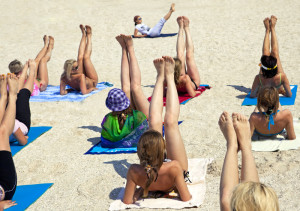Terminology used by personal fitness trainers can sometimes be so confusing and often many first time gym goers are too embarrassed to ask questions to which we feel we should know the answers.

Take for example the times, at the end of your workout, when your personal trainer reminds you to do some anaerobic exercises over the weekend.
Now how are you supposed to know that anaerobic actually means “without oxygen” and aerobic means “with oxygen”? Which leads to the next question – how am I going to exercise without oxygen? 🙂
Ok, so here’s a heads up on what to do!
When we do aerobic exercises, we exercise our cardiovascular system and our respiratory system by supplying an increased amount of oxygen to the bloodstream.
Aerobic exercise, which is often referred to as cardio, burns calories (and fat), strengthens your heart muscles, tones your body and has to leave you short of breath before it does you any good. It is that breathless feeling after a good aerobic workout that makes you feel that you have actually achieved something good with your exercise. Aerobic exercise is centred more around endurance.
Examples of aerobic exercises are running, swimming, dancing, aerobic exercise classes, rowing and anything else that gets your lungs working and your heart beating faster.
Anaerobic exercises are done by carrying out short high intensity exercises. This form of movement is intense enough to trigger lactic acid formation and also increases a substantial deficit of oxygen. Anaerobic exercises strengthen your bones, increases your speed and power and builds muscle mass for those heavy duty workouts.
Examples of anaerobic exercises are weight lifting, box jumping, pull-ups, push-ups, running up stairs, hill sprints and anything that gets your muscles working hard and often leaves you sore the next day.
So, the next time your fitness trainer wants to know if you remembered to do your anaerobic exercises over the weekend, you can confidently answer, because you know you will not make the mistake of saying you went for a 5 kilometre run or did 50 lengths in the local swimming pool!
Here I have also provided for you a more comprehensive explanation of aerobic exercise and aerobic versus anaerobic exercise.
Hope this helps.
Leave a Reply